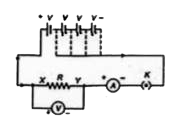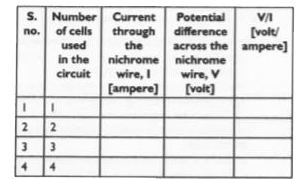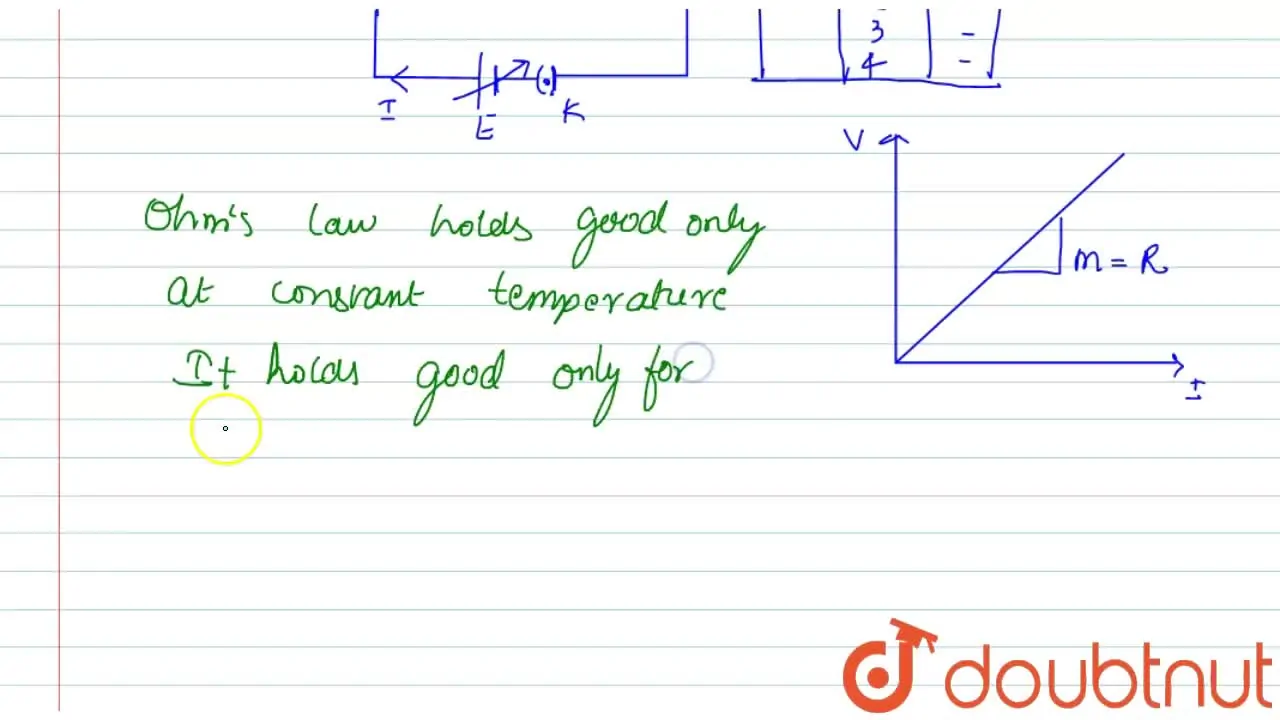State Ohm's law? How can it be verified experimentally? Does it hold good under all conditions? Comment.Solution in Kannada
According to Ohm.s law the electric current flowing through a conductor is directly proportional to the potential difference applied across its ends provided the physical conditions such as temperature etc remains unchanged.
Let V be the potential difference applied across the ends of conductor through which current I flows, then according to Ohm.s law.
V proportional to I→V=IR
Ohm.s law can be verified experimentally by the activity given below:
i] Firstly, set up a circuit as shown in figure given below, consisting of a nichrome wire XY of length, say 0.5 m, an ammeter, a voltmeter and four cells of 1.5 V each. [Nichrome is an alloy of nickel,chromium, manganese, and iron metals.]

ii] First use only one cell as the source in the circuit. Note the reading in the ammeter I, for the current and reading of the voltmeter V for the potential difference across the nichrome wire XY in the circuit. Tabulate them in the Table given.

iii] Next connect two cells in the circuit and note the respective readings of the ammeter and voltmeter for the values of current through the nichrome wire and potential difference across the nichrome wire.
iv] Repeat the above steps using three cells and then four cells in the circuit separately.
v] Calculate the ratio of V to 1 for each pair of potential difference V and current I.
vi] Plot a graph between V and I. The graph will be a straight line as shown below.

vii] This verifies the Ohm.s law.
Related Playlists
- BOOK - ZEN PUBLICATIONCHAPTER - ELECTRICITYEXERCISE - ZEN ADDITIONAL QUESTIONS SECTION (MULTIPLE CHOICE QUESTIONS)60videos
ELECTRICITY
- BOOK - ZEN PUBLICATIONCHAPTER - ELECTRICITYEXERCISE - ZEN ADDITIONAL QUESTIONS SECTION (SHORT ANSWER TYPE 2 QUESTIONS)24videos
ELECTRICITY
- BOOK - ZEN PUBLICATIONCHAPTER - LIGHT - REFLECTION AND REFRACTIONEXERCISE - ZEN ADDITIONAL QUESTIONS SECTION (LONG ANSWER [LA] QUESTIONS)30videos
LIGHT - REFLECTION AND REFRACTION
Similar Questions
A cell, a resistor, a key and ammeter are arranged as shown in the circuit diagrams. The current recorded in the ammeter will be
 03:53View Solution
03:53View SolutionThree 2Ω resistors, A, B and C, are connected as shown in figure. Each of them dissipates energy and can withstand a maximum power of 18 W without melting. Find the maximum current that can flow through the three resistors?
 05:41View Solution
05:41View SolutionDraw ray diagrams showing the image formation by a concave mirror when an object is placed.
(a) between pole and focus of the mirror
(b) between focus and centre of curvature of the mirror
(c ) at centre of curvature of the mirror
(d) a little beyond centre of curvature of the mirror
(e ) at infinity01:14View SolutionState Ohm's law ? How can it be verified experimentally ? Does it hold good under all conditions ? Comment.
03:53View SolutionState Ohm's law. How can it be verified experimentally ? Explain with the help of a circuit diagram. Express the result graphically.
03:53View SolutionIn Gallium arsenide material, Ohm's law does not hold good because
03:53View SolutionUnder which conditions does the law of independent assortment hold good and why?
06:27View SolutionUnder which conditions does the law of independent assortment hold good and why?
View SolutionUnder which conditions does the law of independent assortment hold good and why?
05:23View SolutionState the law of conservation of mass. How is it verified experimentally ?
04:08View SolutionState ohm's law. How can it verified experimentally? Does it hold good in all conditions? Comment.
05:35View SolutionState Ohm's law ? How can it be verified experimentally ? Does it hold good under all conditions ? Comment.
06:35View SolutionState Ohm's law. How can it be verified experimentally ? Explain with the help of a circuit diagram. Express the result graphically.
02:39View SolutionState Hooke’s law. How can it be verified experimentally ?
06:08View SolutionWhat is ohm's law? How can it be verified?
01:42View Solution


